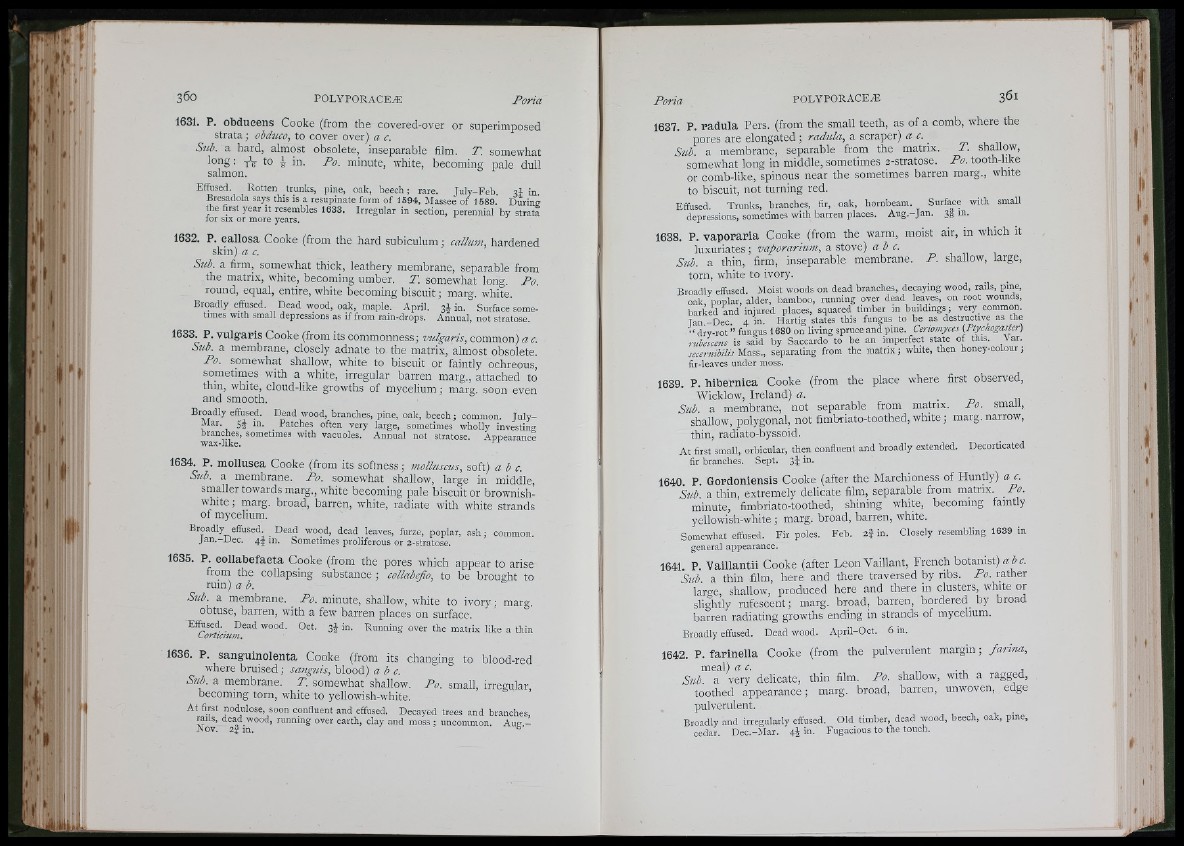
r ft'
f'
- ;
f
Y
I ri
'd
I
I
» I
t
r . ; .
Í ,
Yri
1631. P. obdueens Cooke (from the covered-over or superimposed
strata; obduco, to cover over) a c.
Sub. a hard, almost obsolete, inseparable film. T. somewhat
long: ttt
to Po. minute, white, becoming pale dull
salmon.
Effused. Rotten trunks, pine, oak, beech; rare. July-Feb. 3® in
Bresadola says this is a resupinate form of 1594, Massee of 1589.' During
the first year it resembles 1633. Irregular in section, perennial by strata
for SIX or more years.
1632. P. callosa Cooke (from the hard subiculum; callum, hardened
skin) a c.
Sub. a firm, somewhat thick, leathery membrane, separable from
the matrix, white, becoming umber. T. somewhat long. Po.
round, equal, entire, white becoming biscuit; marg. white.
Broadly effused. Dead wood, oak, maple. April. 3® in. Surface sometimes
with small depressions as if from rain-drops. Annual, not stratose.
1633. P. vulgaris Cooke (from its commonness; vulgaris, common) a c.
Sub. a membrane, closely adnate to the matrix, almost obsolete.
Po. somewhat shallow, w'hite to biscuit or faintly ochreous,
sometimes with a white, irregular barren marg., attached to
thin, white, cloud-like grow'ths of mycelium; marg. soon even
and smooth.
Broadly effused. Dead wood, branches, pine, oak, beech; common. July-
Mar. 5^ in. Patches often very large, sometimes wholly investing
branches, sometimes with vacuoles. Annual not stratose. Appearance
wax-like. ^
1634. P. mollusea Cooke (from its softness; molhiscus, soft) abc.
Sub. a membrane. Po. somewhat shallow, large in middle,
smaller towards marg., white becoming pale biscuit or brownish!
white; marg. broad, barren, white, radiate with white strands
of mycelium.
Broadly effused. Dead wood, dead leaves, furze, poplar, ash; common.
Jan.-Dec. 4® in. Sometimes proliferous or 2-siratose.
1635. P. eollabefaeta Cooke (from the pores which appear to arise
froni the collapsing substance; collabefio, to be brought to
rum) a b.
Sub a membrane. Po. minute, shallow, white to ivory; marg.
obtuse, barren, with a few barren places on surface.
Effused. Dead wood. Oct. 3® in. Running over the matrix like a thin
Cortiaum.
1636. P. sanguinolenta Cooke (from its changing to blood-red
where bruised; sanguis, blood) abc.
Sub. a membrane. T. somewhat shallow. Po. small, irregular
becoming torn, white to yellowish-white. ’
At first nodulose, soon confluent and effused. Decayed trees and branches,
rails, dead wood, running over earth, clay and moss; uncommon. Aug -
-Nov. 2| in. ^
1637. P. radula Pers. (from the small teeth, as of a comb, where the
pores are elongated ; radula, a scraper) a c. ^
Sub. a membrane, separable from the matrix. T. shallow,
somewhat long in middle, sometimes 2-stratose. Po. tooth-hke
or comb-like, spinous near the sometimes barren marg., white
to biscuit, not turning red.
Effused. Trunks, branches, fir, oak, hornbeam. Surface with small
depressions, sometimes with barren places. Aug.-Jan. 3® in.
1638. P. vaporaria Cooke (from the warm, moist air, in which it
luxuriates ; vaporarium, a stove) abc.
Sub. a thin, firm, inseparable membrane. P. shallow, large,
torn, white to ivory.
Broadly effused. Moist woods on dead branches, decaying wood, rails, pine,
oak poplar, alder, bamboo, running over dead leaves, on root wounds,
barked and injured places, squared timber in buildings ; very common.
Tan -Dec. 4 in. Hartig states this fungus to be as destructive as the
“ dry-rot ” fungus 1680 on living spruce and pine. Ceriomyces (Ptychogaster)
rubescens is said by Saccardo to be an imperfect state of this. Var.
secernibilis M.S.SS., separating from the matrix; white, then honey-colour;
fir-leaves under moss.
1639. P. hiberniea Cooke (from the place where first observed,
Wicklow, Ireland) a. • 7, n
Sub. a membrane, not separable from matrix. Po. small,
shallow, polygonal, not fimhriato-toothed, white ; marg. narrow,
thin, radiato-byssoid.
At first small, orbicular, then confluent and broadly extended. Decorticated
fir branches. Sept. 3| in.
1640. P. Gordoniensis Cooke (after the Marchioness of Huntly) a c.
Sub. a thin, extremely delicate film, separable from matrix ^ Po.
minute, fimbriato-toothed, shining white, becoming faintly
yellowish-white ; marg. broad, barren, white.
Somewhat effused. Fir poles. Feb. 2§ in. Closely resembling 1639 in
general appearance.
1641 P. Vaillantii Cooke (after Leon Vaillant, French botanist) a i c.
'Sub a thin film, here and there traversed by ribs. Po. rather
large, shallow, produced here and there in clusters, white or
slightly rufescent; marg. broad, barren, bordered^ by broad
barren radiating growths ending in strands of mycelium.
Broadly effused. Dead wood. April-Oct. 6 in.
1642. P. farinella Cooke (from the pulverulent margin ; farina,
meal) a c. , , j
Sub. a very delicate, thin film. Po. shallow, with a ragged,
toothed appearance ; marg. broad, barren, unwoven, edge
pulverulent.
Broadly and irregularly effused. Old timber, dead wood, beech, oak, pine,
cedar. Dec.-ilar. 4 i in- Fugacious to the touch.
ll•fl4
Ad
K
ri
, I